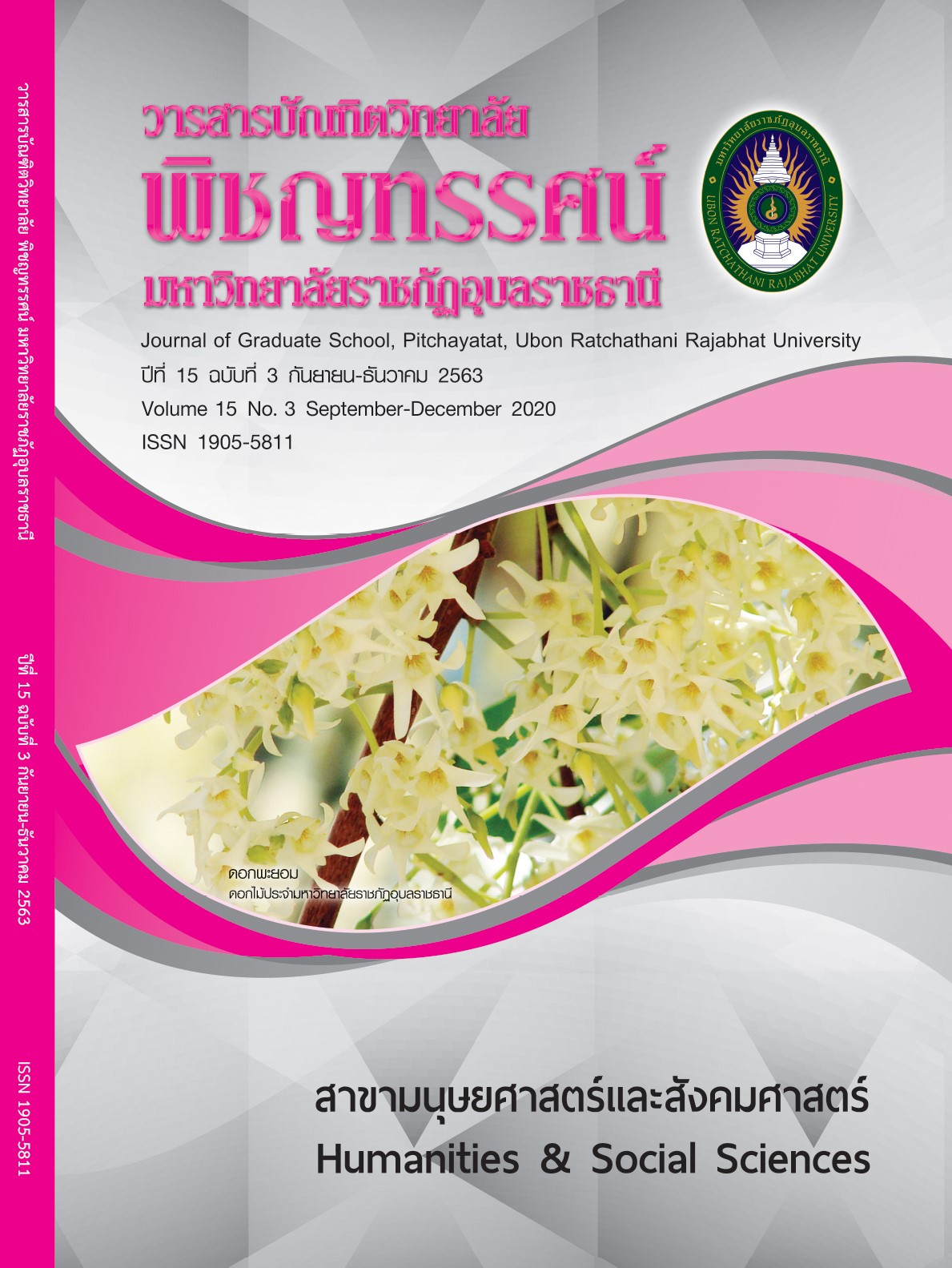การพัฒนาหนังสืออิเล็กทรอนิกส์แบบการ์ตูนเรื่องคุณลักษณะอันพึงประสงค์ 8 ประการ สำหรับนักเรียนชั้นประถมศึกษาปีที่ 4 โรงเรียนวัดดอนดำรงธรรม จังหวัดชลบุรี
คำสำคัญ:
หนังสืออิเล็กทรอนิกส์, คุณลักษณะอันพึงประสงค์ 8 ประการบทคัดย่อ
การวิจัยนี้มีวัตถุประสงค์เพื่อ 1) พัฒนาหนังสืออิเล็กทรอนิกส์แบบการ์ตูนเรื่องคุณลักษณะอันพึงประสงค์ 8 ประการ สำหรับนักเรียนชั้นประถมศึกษาปีที่ 4 โรงเรียนวัดดอนดำรงธรรม จังหวัดชลบุรี ให้มีประสิทธิภาพตามเกณฑ์ E1/ E2 = 80/ 80 2) เปรียบเทียบคะแนนทดสอบก่อนเรียนและหลังเรียนจากหนังสืออิเล็กทรอนิกส์แบบการ์ตูนเรื่องคุณลักษณะอันพึงประสงค์ 8 ประการ และ 3) ศึกษาความพึงพอใจของนักเรียนที่ มีต่อหนังสืออิเล็กทรอนิกส์แบบการ์ตูนเรื่องคุณลักษณะอันพึงประสงค์ 8 ประการ ตัวอย่างเป็นนักเรียนชั้นประถมศึกษาปีที่ 4 โรงเรียนวัดดอนดำรงธรรม จังหวัดชลบุรี ปีการศึกษา 2561 จำนวน 33 คน ได้มาโดยการเลือกแบบเจาะจง เครื่องมือที่ใช้คือ 1) หนังสืออิเล็กทรอนิกส์แบบการ์ตูนเรื่องคุณลักษณะอันพึงประสงค์ 8 ประการ สำหรับนักเรียนชั้นประถมศึกษาปีที่ 4 2) แบบทดสอบเรื่องคุณลักษณะอันพึงประสงค์ 8 ประการ 3) แบบฝึกหัดระหว่างเรียน และ 4) แบบสอบถามความพึงพอใจของนักเรียนที่มีต่อหนังสืออิเล็กทรอนิกส์แบบการ์ตูนเรื่องคุณลักษณะ อันพึงประสงค์ 8 ประการ สำหรับนักเรียนชั้นประถมศึกษาปีที่ 4 สถิติที่ใช้ ได้แก่ ค่าเฉลี่ย ส่วนเบี่ยงเบนมาตรฐาน และการทดสอบที
ผลการวิจัยพบว่า
- หนังสืออิเล็กทรอนิกส์แบบการ์ตูนเรื่องคุณลักษณะอันพึงประสงค์ 8 ประการ สำหรับนักเรียนชั้นประถมศึกษาปีที่ 4 โรงเรียนวัดดอนดำรงธรรม จังหวัดชลบุรี มีค่าประสิทธิภาพ E1/ E2 = 80.83/ 81.92
- คะแนนจากการทดสอบหลังเรียนสูงกว่าก่อนเรียน อย่างมีระดับนัยสำคัญทางสถิติที่ระดับ .01
- นักเรียนมีความพึงพอใจต่อการเรียนด้วยหนังสืออิเล็กทรอนิกส์แบบการ์ตูนเรื่องคุณลักษณะอันพึงประสงค์ 8 ประการ สำหรับนักเรียนชั้นประถมศึกษาปีที่ 4 โดยรวมอยู่ในระดับมากที่สุด มีค่าเฉลี่ย 4.53
เอกสารอ้างอิง
(มกราคม-เมษายน 2545): 1-18.
ฉลอง ทับศรี. เอกสารการสอน การพัฒนา CAI ด้วยมัลติมีเดีย การฝึกอบรม การพัฒนา CAI ด้วย Authorware. ชลบุรี: ภาควิชาเทคโนโลยีทางการศึกษา คณะศึกษาศาสตร์ มหาวิทยาลัยบูรพา, 2538.
ชัยยงค์ พรหมวงศ์. เทคโนโลยีและสื่อสารการศึกษา หน่วยที่ 1-5. นนทบุรี: มหาวิทยาลัยสุโขทัยธรรมธิราช, 2528.
ชัยยงค์ พรหมวงศ์ และคณะ. นวกรรมและเทคโนโลยีทางการศึกษา. กรุงเทพฯ: ไทยวัฒนาพานิช, 2531.
บุญเชิด ภิญโญอนันตพงษ์. การวัดประเมินการเรียนรู้. กรุงเทพฯ: คณะศึกษาศาสตร์ มหาวิทยาลัยศรีนครินทรวิโรฒ, 2545.
ล้วน สายยศ และอังคณา สายยศ. เทคนิคการวิจัยทางการศึกษา. พิมพ์ครั้งที่ 4. กรุงเทพฯ: สุวีริยาสาส์น, 2538.
ล้วน สายยศ และอังคณา สายยศ. เทคนิคการวัดผลการเรียนรู้. กรุงเทพฯ: สุวีริยาสาส์น, 2539.
ศิริณี จันทรชาติ. การพัฒนาหนังสืออิเล็กทรอนิกส์แบบการ์ตูน กลุ่มสาระการเรียนรู้สังคมศึกษา ศาสนา และวัฒนธรรม เรื่อง เรียนรู้สังคมมนุษย์ สำหรับนักเรียนชั้นมัธยมศึกษาปีที่ 4. วิทยานิพนธ์การศึกษา
มหาบัณฑิต มหาวิทยาลัยทักษิณ, 2556.
ศุภพักตร์ จารุเศรณี. การสร้างภาพยนตร์แอนิเมชั่นเพื่อส่งเสริมพฤติกรรมการออมแก่เยาวชน. การค้นคว้าแบบอิสระศิลปศาสตรมหาบัณฑิต มหาวิทยาลัยเชียงใหม่, 2552.
ศึกษาธิการ, กระทรวง. หลักสูตรแกนกลางการศึกษาขั้นพื้นฐาน พุทธศักราช 2551. กรุงเทพฯ: โรงพิมพ์ชุมนุมสหกรณ์การเกษตรแห่งประเทศไทย จำกัด, 2552.
สังเขต นาคไพจิตร. การ์ตูน. มหาสารคาม: ปรีดาการพิมพ์, 2530.
สิริวิวัฒน์ ละตา. การพัฒนาการ์ตูนแอนิเมชัน 3 มิติ เรื่องการละเล่นสำหรับเด็กเพื่อส่งเสริมเอกลักษณ์ไทย. การศึกษาค้นคว้าอิสระวิทยาศาสตรมหาบัณฑิต มหาวิทยาลัยมหาสารคาม, 2553.
อนงค์ กล้าหาญ. การพัฒนาการ์ตูนแอนนิเมชั่นเรื่องความดีของปุ๊กปิ๊ก เพื่อเสริมสร้างคุณลักษณะอันพึงประสงค์ 8 ประการ สำหรับนักเรียนชั้นประถมศึกษาปีที่ 3. วิทยานิพนธ์การศึกษามหาบัณฑิต มหาวิทยาลัยบูรพา, 2556.
ดาวน์โหลด
เผยแพร่แล้ว
รูปแบบการอ้างอิง
ฉบับ
ประเภทบทความ
สัญญาอนุญาต
บทความทุกเรื่องได้รับการตรวจความถูกต้องทางวิชาการโดยผู้ทรงคุณวุฒิภายนอกอย่างน้อย 3 คน ความคิดเห็นในวารสารพิชญทรรศน์เป็นความคิดเห็นของผู้นิพนธ์มิใช่ความคิดเห็นของผู้จัดทำ จึงมิใช่ความรับผิดชอบของวารสารพิชญทรรศน์ และบทความในวารสารพิชญทรรศน์สงวนสิทธิ์ตามกฎหมายไทย การจะนำไปเผยแพร่ต้องได้รับอนุญาตเป็นลายลักษณ์อักษรจากกองบรรณาธิการ





